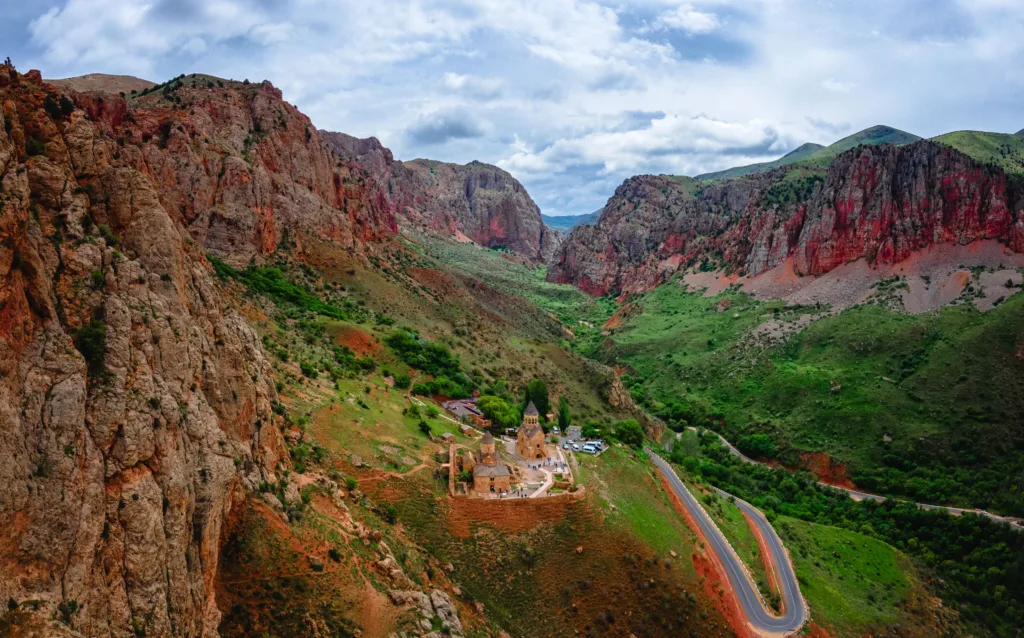
Armenia, a land where history intertwines with breathtaking natural beauty, welcomes adventurous travelers with a passion for culture and history. In this guide, we embark on a journey to explore the captivating Noravank Monastery, nestled among the vibrant red mountains of Armenia’s Vayots Dzor region.
Table of Contents
Unveiling Armenia’s Rich Heritage
The Christian Roots of Armenia
Armenia boasts an ancient history despite its current compact size. The nation’s significance shines through its pioneering role in adopting Christianity as the State religion in 301 AD, setting the stage for the abundance of monasteries and churches that dot the country today.
One of these remarkable sites is the Noravank Monastery, a Monastic Complex that seamlessly weaves together history, spirituality, and natural grandeur.
The Allure of Noravank Monastery
As someone relatively impartial to religious sites, what drew me to Noravank was its diverse appeal. Nestled in the Amaghu Gorge, this historical gem offers a compelling fusion of architectural brilliance, natural wonder, and spiritual significance.
The journey from Yerevan to Noravank, passing through the picturesque Ararat plain, is an experience in itself. The scenery transforms from the ordinary surroundings of the capital to endless lush fields and, eventually, to the red and rugged mountains adorned with vineyards.
As I approached the red cliffs cradling Noravank Monastery, I was struck by the dramatic setting, a prelude to the grandeur that awaited.
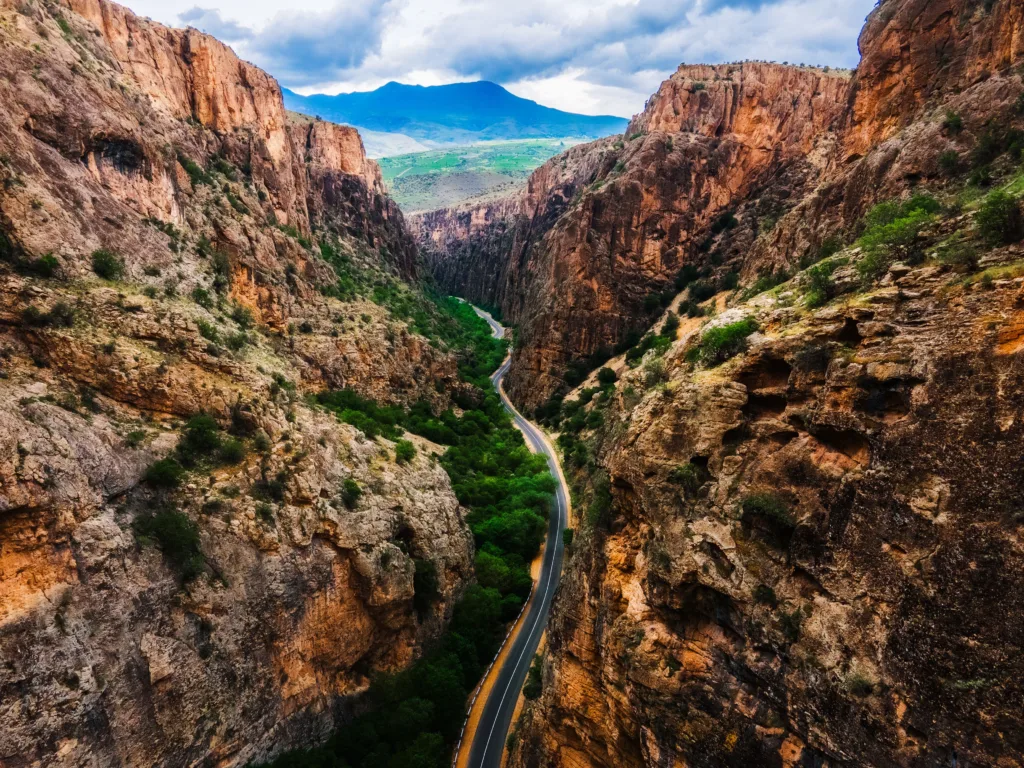
Entering the Amaghu Gorge, just after departing from the village of Areni, a sense of arriving somewhere truly special washed over me. Although it’s only a 15-minute drive from the gorge’s entrance to Noravank, I found myself taking more than an hour due to strategic stops for breathtaking views and a couple of drone flights.
Finally, breaking free from the enchantment the canyon had cast on me, I ventured further until I spotted Noravank, perched on a cliff below vibrant red rock walls, reminiscent of the area’s famed red wine. It was time to explore Noravank.
Origins of Noravank Monastery
Let’s delve into the origins of Noravank Monastery. Founded in the early 12th century by Bishop Hovhannes, it emerged as a hub of spiritual and cultural activity during medieval Armenia’s subsequent centuries.
The name “Noravank,” meaning “New Monastery,” was apt for its time but has since evolved. It’s possible that the name stems from some unconventional architectural choices made during its construction.
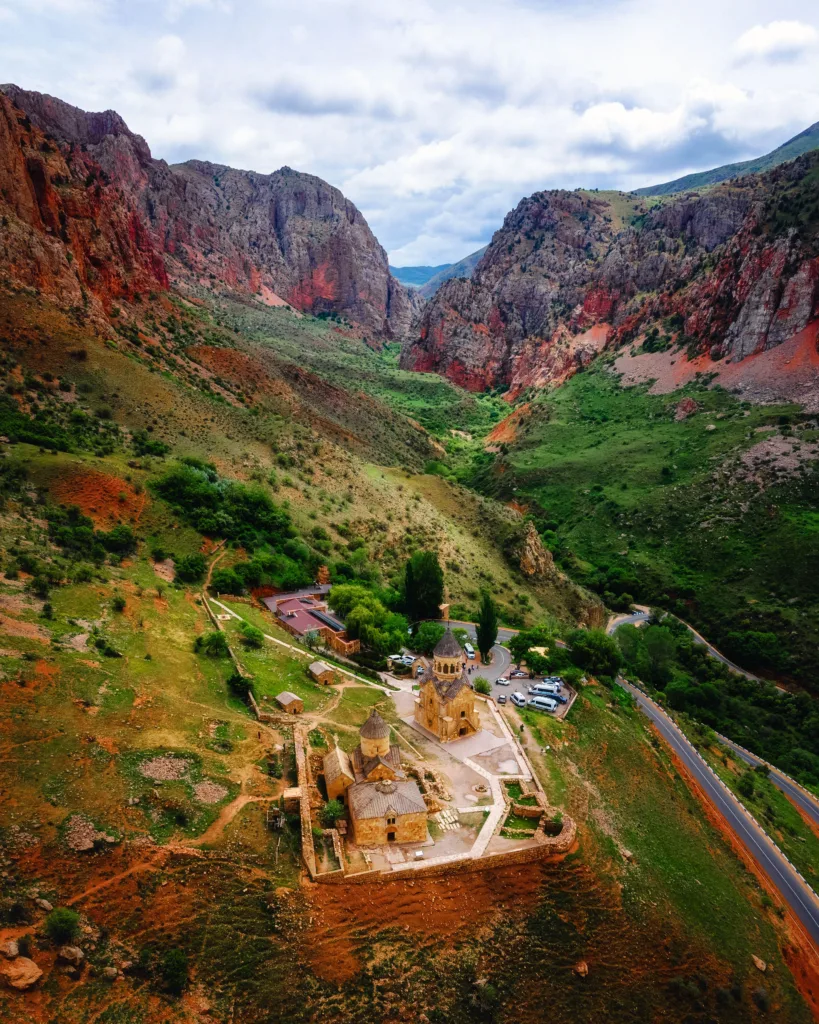
Architectural Brilliance
The departure from tradition is evident in the design of Surb Astvatsatsin Church, one of Noravank’s masterpieces. This unique design allowed for a more inclusive and communal worship space, setting Noravank apart from its contemporary monasteries.
Moreover, Surb Astvatsatsin is a two-story building, with the main area on the top floor, accessed by narrow and steep stairs adjacent to the front facade. This could be quite challenging for those with a fear of heights or during the winter months.
Noravank Monastery, with its graceful lines and intricate details, stands as a testament to the craftsmanship of its time. Each stone in this magnificent complex seems to whisper tales of the past, inviting visitors to step back in time.
Notably, the site features many Khachkars, cross-stones adorning the churches, exquisite examples of intricate stone carving, a significant artistic heritage of Armenia. These Khachkars served both religious and artistic purposes, adding layers of symbolism and beauty to the spiritual ambiance of Noravank.
Noteworthy Structures
Within Noravank Monastery, you’ll encounter not only Surb Astvatsatsin Church but also the Surb Karapet Church and the Surb Grigor Chapel, each with its unique character and historical significance.
Surb Karapet Church showcases an architectural innovation known as the “gavit,” a feature seen in only a few churches before at the time, an enclosed antechamber that connects to the main church.
Surprisingly, Surb Astvatsatsin, the main church, was the last to be completed, with work finishing in 1339, whereas the other structures were completed in the preceding century. This diverse range of structures presents a mosaic of architectural styles, offering an enthralling journey through Armenia’s artistic heritage.
Embracing Natural Beauty
A Breathtaking Landscape
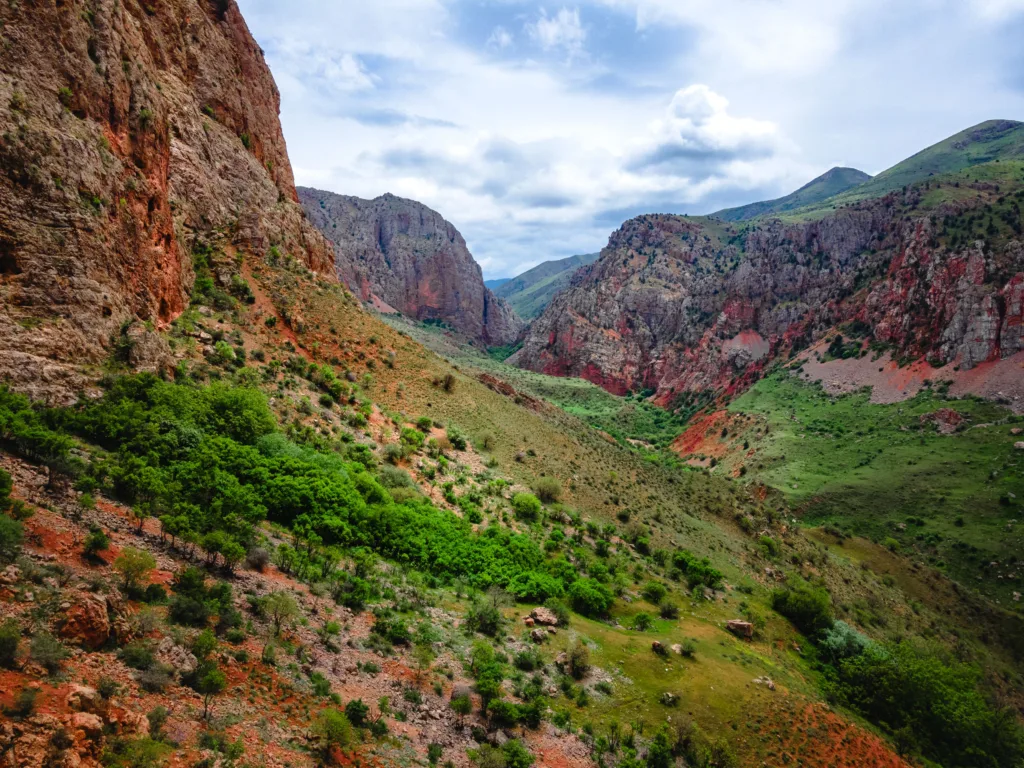
In the Vayots Dzor region, where Noravank is nestled, the landscape becomes an integral part of the adventure.
The distinctive red color of the cliffs and mountains in the region results from the geological composition, specifically the presence of iron oxide, known as rust.
Over millions of years, these rocks have been exposed to natural processes such as weathering, erosion, and chemical reactions. The oxidization of iron minerals in the rocks creates the iconic reddish hues that define the area.
This natural phenomenon has not only contributed to the unique and picturesque landscapes but has also shaped the cultural and historical identity of the region, often featuring prominently in local folklore and traditions.
Visitors are invariably captivated by the striking contrast between the red cliffs and lush greenery, making Vayots Dzor an exceptionally remarkable destination in Armenia.
Hiking and Exploration around Noravank Monastery
For the adventurous souls among us, Noravank Monastery offers numerous hiking trails leading to panoramic viewpoints. One of the most enchanting hikes is the Noravank-Gnishik trail.
The Gnishik River Gorge, part of the expansive Arpa Protected Landscape, lies to the south of Noravank Monastery and ventures into some of Armenia’s wildest terrain. While permits are required for hiking, they are well worth the experience.
The Gnishik River Canyon boasts around 900 plant species and 525 animal species, including the majestic Bezoar Ibex, a climber that might grace your journey. Additionally, be vigilant for bears, as they are not uncommon in the area.
My personal exploration was limited to the complex’s grounds and the surrounding cliffs on a leisurely stroll. Venturing higher up the mountain sides provides breathtaking views of Noravank’s classic composition.
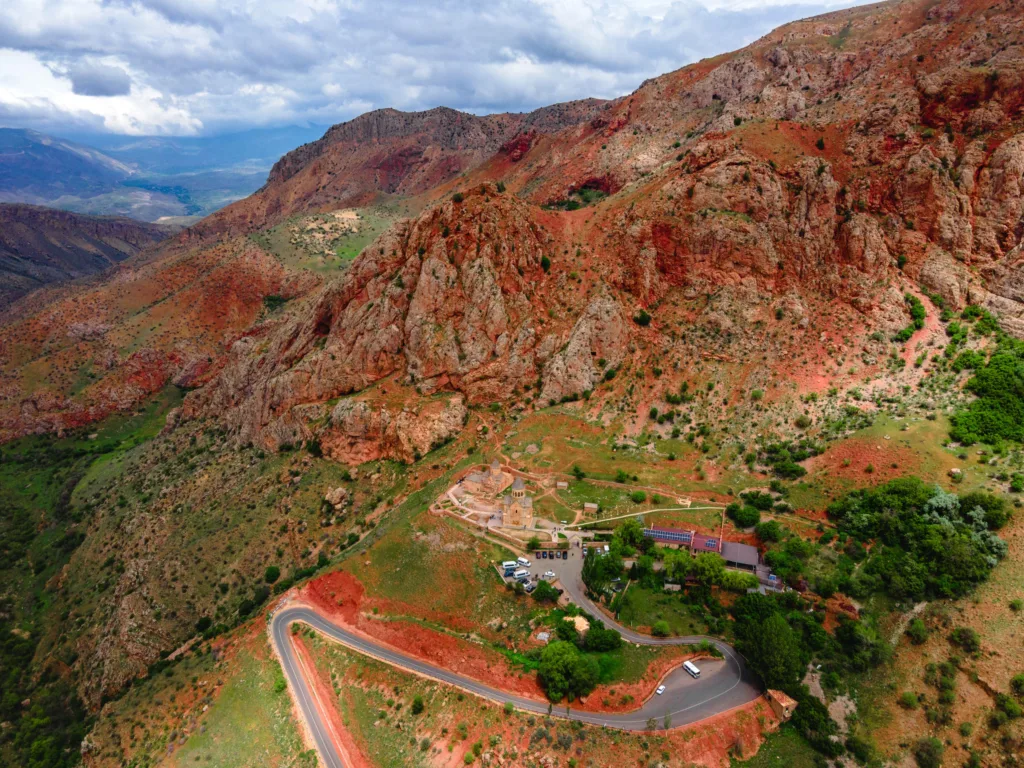
Another special area in Armenia where hikes and adventures are the bread and butter is the Syunik region. I went on a road trip exploring every corner of the deep South of Armenia on this same trip, and you can read about it here.

Seasonal Variations
Noravank Monastery exhibits its charm in varying ways throughout the seasons.
Winter drapes the cliffs in a pristine blanket of snow, creating a tranquil landscape where the subtle red hues still shine through. Autumn transforms the scene with a burst of colors as foliage changes, while summer gifts warm, sun-soaked days for exploration.
In spring, the gorge comes to life with a riot of wildflowers, adding to the enchantment.
Regardless of when you visit, Noravank Monastery never ceases to captivate with its ever-changing beauty.
How to Reach Noravank Monastery
By Car
To reach Noravank Monastery, I recommend the scenic drive from Yerevan. The journey itself is a visual delight, spanning picturesque villages, semi-desert landscapes, and vineyards. Covering approximately 120 kilometers, the drive takes around two to three hours, allowing you to savor Armenia’s evolving landscapes.
By Bus (Marshrutka)
An affordable and convenient option to reach Noravank is to utilize the public transport system. Finding the right Marshrutka location might be slightly more challenging compared to some other countries, but it’s manageable. To reach Noravank, the nearest towns accessible by Marshrutka are Areni or Yeghegnadzor.
I had to take it from this location during my visit, as the official Marshrutka schedules often failed to indicate the correct station. The bus should leave bi-hourly.
However, don’t take my word for it. Checking the official website might provide more reliable information.
Once you arrive in Yeghegnadzor or Areni, the only way to reach Noravank Monastery is by taxi unless you’re up for a lengthy hike through the canyon. I used Yandex Taxi, but you can also opt for GG.
By Taxi
For those seeking a straightforward option, bypassing potential confusion, Yandex Taxi or GG are reliable choices for reaching Noravank. Expect to pay approximately 40-50€ for the entire car, a reasonable price given the three-hour journey. If you’re traveling with a larger group, this option becomes even more attractive.
Entrance Fees and Visiting Hours
Noravank Monastery doesn’t charge an entry fee or ticket, although parking may cost 100AMD (0.25€). Typically, Noravank is open from 9:00 am to 6:00 pm. Checking the latest information before planning your visit is advisable for a seamless experience.
Accommodation and Dining Options
While Noravank Monastery itself doesn’t offer accommodations, nearby villages like Areni provide charming guesthouses and hotels. During my stay in one of these guesthouses, I enjoyed delectable Armenian cuisine. The homemade wine, a taste of Armenia’s rich winemaking traditions, left an indelible mark.

In conclusion, Noravank Monastery stands as a testament to Armenia’s enduring spirit.
It’s a place where the past animates amidst the awe-inspiring beauty of the present. As you explore its historical treasures, traverse its rugged trails, and immerse yourself in its culture, you’ll understand why Noravank Monastery transcends being just a destination; it’s an experience that lingers in your heart long after you’ve departed.
When you set foot on Armenian soil, ensure Noravank Monastery graces your itinerary. It’s a journey you’ll cherish, creating a memory that will endure. Armenia’s hidden artistic marvel awaits your discovery amidst the captivating landscapes of the Vayots Dzor region.